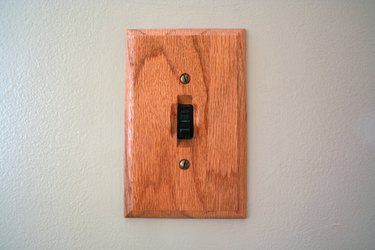
The light switch is a common household device that is also one of the most overlooked—at least until you have trouble with it. Although not tremendously complicated, main lighting switches still require a certain level of understanding prior to being worked on, especially since they utilize electrical power. Always ensure that prior to working with wires from a light switch to turn off all power to the circuit. After that, understanding the basic components of the light switch can be an easy task.
The Switch and Plate
Video of the Day
The first and foremost parts of the light switch are the parts that everyone deals with on a day-to-day basis: the switch and the plate. The plate serves as the aesthetic barrier that covers the hole in the wall. Behind the plate are the inner workings of the main light switch.
Video of the Day
The switch is the actual object that you switch up and down. The switch is the part that connects to terminals through wires, controlling whether the light is on or off.
Wires
One thing that is clearly visible after removal of the plate is the wires that run from the actual switch to the terminal within the wall. These wires are responsible for transmitting to the terminal whether to turn the light on or off based on the position of the switch as dictated by the homeowner.
The number of wires depends on the location of the light switch and whether it is on the end of a circuit or within the center. Light switches that are on the end usually have 3 wires; a green, white and black wire. Middle-circuit switches generally have two sets of wires for each of these colors. Wires in this circumstance are usually attached to terminals and often times to wire connectors as well. Always remember to never repair or alter electrical wires without ensuring the power is turned off at the fusebox.
Terminals
The terminals provide a destination for the wires, as dictated by the direction of the switch. It sends the electrical signal through the circuit and to the actual circuitry within the wall and ultimately to the light source. Any loose connections to the terminal can result in malfunctions within the switches. The terminal normally features a plastic device which can be turned, tying down the wires, ensuring that the wires are held securely together.